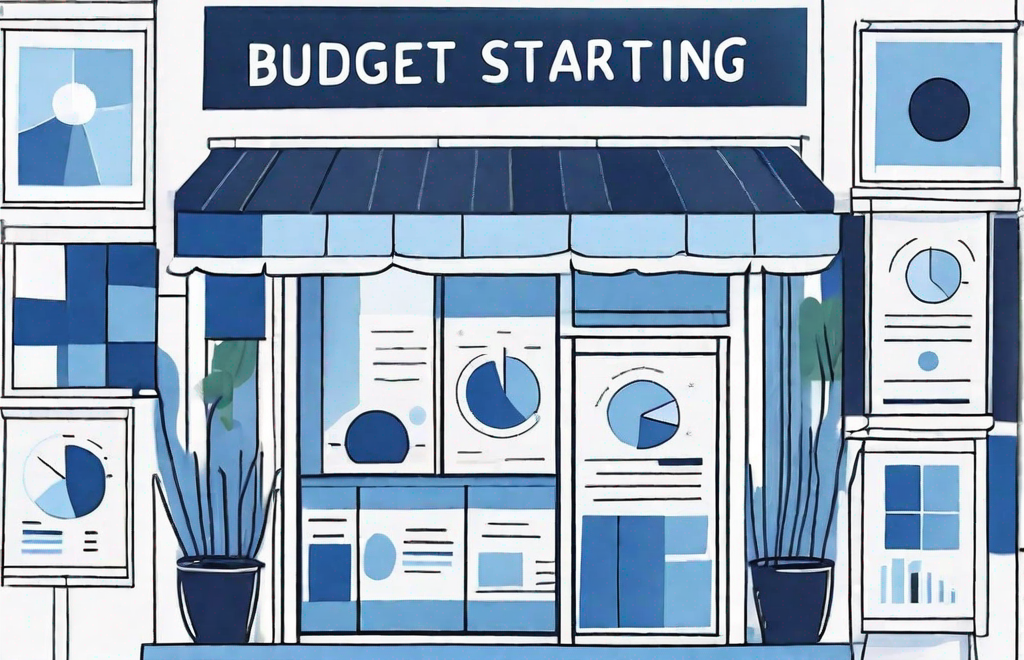In today’s competitive business landscape, small businesses need to allocate their resources wisely to ensure their survival and success. One crucial aspect of resource allocation for small businesses is the marketing budget. Understanding what constitutes an average marketing budget for a small business is essential for making informed decisions and maximizing your marketing efforts. In this article, we will dive deep into the various aspects of a marketing budget, factors influencing its size, how to calculate it, and tips for effectively allocating and maximizing it.
Understanding the Concept of a Marketing Budget
Before delving into the specifics, let’s first understand what a marketing budget entails. A marketing budget is a financial plan that outlines the resources allocated to marketing activities within a specific period. It sets the foundation for all your marketing initiatives, including advertising, promotions, public relations, and market research. A well-planned marketing budget ensures that your business’s marketing efforts are strategic, targeted, and deliver desired results.
When creating a marketing budget, it is crucial to consider various factors such as the size of your business, industry trends, and your target audience. By carefully analyzing these factors, you can allocate resources effectively and maximize the impact of your marketing activities.
The Importance of a Marketing Budget
One might question the significance of having a dedicated marketing budget, especially for small businesses with limited resources. The truth is, a marketing budget is not an expense but an investment. It allows you to allocate resources effectively and efficiently towards activities that will yield maximum returns. By having a budget in place, you can streamline your marketing efforts, avoid overspending, and stay focused on achieving your business goals.
Moreover, a marketing budget provides a clear roadmap for your marketing activities. It helps you prioritize your initiatives, ensuring that you invest in strategies that align with your business objectives. Without a budget, you may find yourself scattered and unable to measure the success of your marketing efforts.
Key Components of a Marketing Budget
A marketing budget comprises several key components that collectively determine its size and effectiveness. These components may vary based on your business’s unique requirements and goals, but some common elements include:
- Advertising expenses, including print, radio, television, and online ads.
- Marketing collateral, such as brochures, catalogs, and business cards.
- Digital marketing initiatives, including website development, search engine optimization (SEO), and social media marketing.
- Event participation, such as trade shows, conferences, and sponsorship opportunities.
- Public relations efforts, like press releases, media outreach, and content creation.
- Market research activities to gather insights about your target audience, competition, and industry trends.
Advertising is an essential component of any marketing budget. It allows you to reach your target audience through various channels, increasing brand awareness and driving customer engagement. Whether it’s traditional media or digital platforms, allocating a portion of your budget to advertising is crucial for promoting your products or services.
Marketing collateral plays a vital role in conveying your brand’s message and showcasing your offerings. Allocating a budget for creating and printing brochures, catalogs, business cards, and other promotional materials ensures that you have the necessary tools to leave a lasting impression on potential customers.
In today’s digital age, having a strong online presence is crucial for business success. Allocating a portion of your marketing budget to digital marketing initiatives allows you to develop and maintain a user-friendly website, optimize it for search engines, and engage with your target audience through social media platforms. This investment in digital marketing can significantly impact your brand visibility and customer acquisition.
Participating in industry events provides an excellent opportunity to showcase your products or services, network with potential clients, and stay updated on the latest industry trends. Allocating a budget for event participation allows you to secure booth space, create eye-catching displays, and sponsor relevant conferences or workshops, enhancing your brand’s visibility and credibility.
Public relations activities play a crucial role in shaping your brand’s image and reputation. Allocating a portion of your marketing budget to public relations efforts allows you to create compelling press releases, engage with media outlets, and develop valuable content that resonates with your target audience. These efforts can help generate positive publicity, establish thought leadership, and build trust among your customers.
Market research is a fundamental aspect of any marketing strategy. Allocating a budget for market research activities allows you to gather valuable insights about your target audience’s preferences, behavior, and needs. It also helps you stay informed about your competitors’ strategies and industry trends, enabling you to make data-driven decisions and tailor your marketing efforts accordingly.
By considering these key components and allocating resources accordingly, you can create a comprehensive marketing budget that supports your business goals and drives growth. Remember, a well-planned and executed marketing budget is not just an expense but an investment that can yield significant returns for your business.
Factors Influencing the Size of a Marketing Budget
Now that we understand what a marketing budget entails, let’s explore the various factors that can influence its size. The size of your marketing budget should be determined based on the unique needs and goals of your business, as well as external factors that impact your industry.
Business Size and Marketing Budget
Typically, larger businesses have higher marketing budgets compared to smaller ones. This is mainly because larger businesses often have more extensive marketing needs, a wider customer base, and the financial capacity to invest more in marketing initiatives. However, small businesses should not overlook the importance of allocating sufficient resources to marketing, as effective marketing can help level the playing field and drive business growth.
Industry Norms and Marketing Budgets
Another crucial factor to consider when determining your marketing budget is the industry you operate in. Different industries have varying levels of competitiveness, target audiences, and marketing requirements. It is essential to research and analyze industry norms and benchmarks to understand what your competitors are doing and gauge the effectiveness of different marketing strategies and tactics. This research can help you make more accurate budgeting decisions and ensure that your marketing efforts align with industry standards.
Calculating Your Small Business Marketing Budget
Now that we have covered the importance of a marketing budget and the factors that influence its size, let’s explore how you can calculate your small business’s marketing budget. Several methods can be used to determine an appropriate marketing budget, two of which are:
Percentage of Revenue Method
The percentage of revenue method is one of the most commonly used approaches for calculating a marketing budget. As the name suggests, this method involves allocating a certain percentage of your business’s projected revenue towards marketing activities. The exact percentage can vary depending on factors such as industry, growth stage, and business goals. It is recommended to allocate between 5% to 12% of your projected revenue for marketing purposes. However, it is essential to assess your specific circumstances and adjust the percentage based on your unique needs.
Objective and Task Method
The objective and task method involves defining specific marketing objectives and the tasks and resources required to achieve them. This method requires a more detailed approach, where you break down your marketing goals into actionable tasks and estimate the associated costs. By using this method, you can align your marketing budget directly with your business objectives and ensure that every dollar spent contributes to achieving tangible results. It may require more effort in terms of planning and analysis, but it provides a more precise and targeted approach to budgeting.
Allocating Your Marketing Budget
Once you have determined the size of your marketing budget, the next step is to allocate it effectively to different marketing channels and activities. Two important considerations when allocating your marketing budget are:
Traditional Advertising vs. Digital Marketing
Traditional advertising methods, such as print ads and television commercials, have long been the go-to options for businesses. However, with the rise of digital marketing, businesses now have a wide range of cost-effective and highly targeted options at their disposal. When allocating your marketing budget, it is crucial to assess the effectiveness and reach of both traditional and digital marketing channels. Depending on your target audience, industry, and marketing objectives, you can decide on the best mix of traditional and digital marketing tactics.
Prioritizing Marketing Channels
Not all marketing channels and tactics will yield the same results for your business. It’s important to prioritize the channels that have proven to be most effective in reaching and engaging your target audience. Consider factors such as the demographic profile of your ideal customers, their preferred communication channels, and the competitive landscape. By allocating a larger portion of your budget to channels that generate the highest return on investment, you can optimize your marketing efforts and maximize your budget’s impact.
Tips for Maximizing Your Marketing Budget
Allocating and optimizing your marketing budget is an ongoing process. As you implement your marketing initiatives, it’s crucial to track the return on investment (ROI) of each tactic and make adjustments accordingly. Here are a few tips to help you make the most of your marketing budget:
Tracking Marketing ROI
Implement robust tracking mechanisms to measure the effectiveness of your marketing campaigns. This can include using analytics tools to monitor website traffic, lead generation, and conversion rates. By tracking these metrics, you can identify which marketing activities are delivering the best results and make data-driven decisions about where to allocate your budget.
Adjusting Your Budget Based on Performance
Regularly review and analyze the performance of your marketing campaigns. If a particular tactic is not delivering the desired results, consider reallocating the budget to more effective strategies. Business environments are dynamic, and it’s crucial to be flexible and responsive to changing market dynamics. Adjusting your budget based on performance ensures that you are continuously optimizing your marketing efforts and maximizing the return on your investment.
In conclusion, the average marketing budget for a small business can vary depending on various factors. By understanding the concept of a marketing budget, analyzing industry norms, and using appropriate budgeting methods, small businesses can allocate their resources effectively. Additionally, by prioritizing marketing channels and tracking ROI, businesses can maximize their marketing efforts and achieve optimal results. Remember, a well-planned and strategically allocated marketing budget is an investment that can drive the growth and success of your small business.







